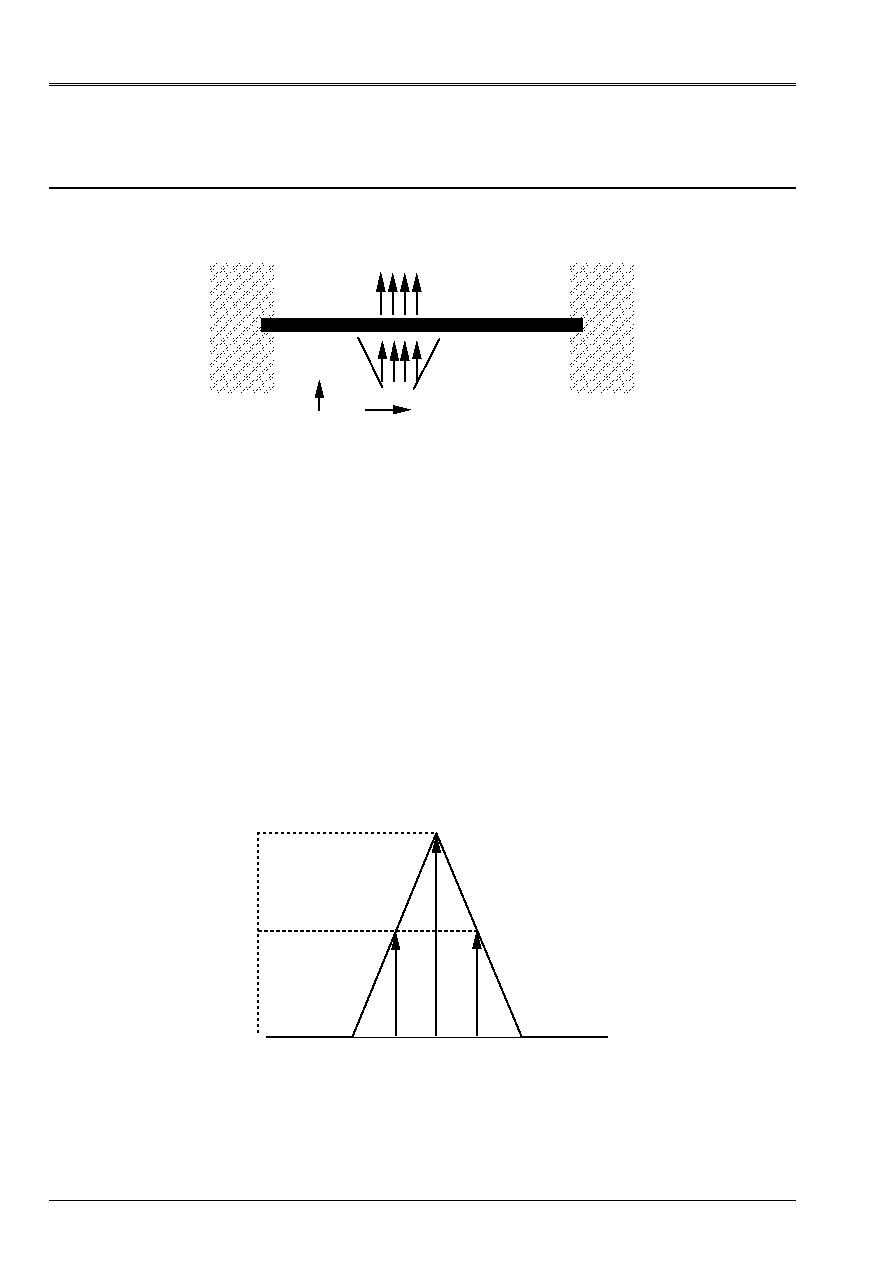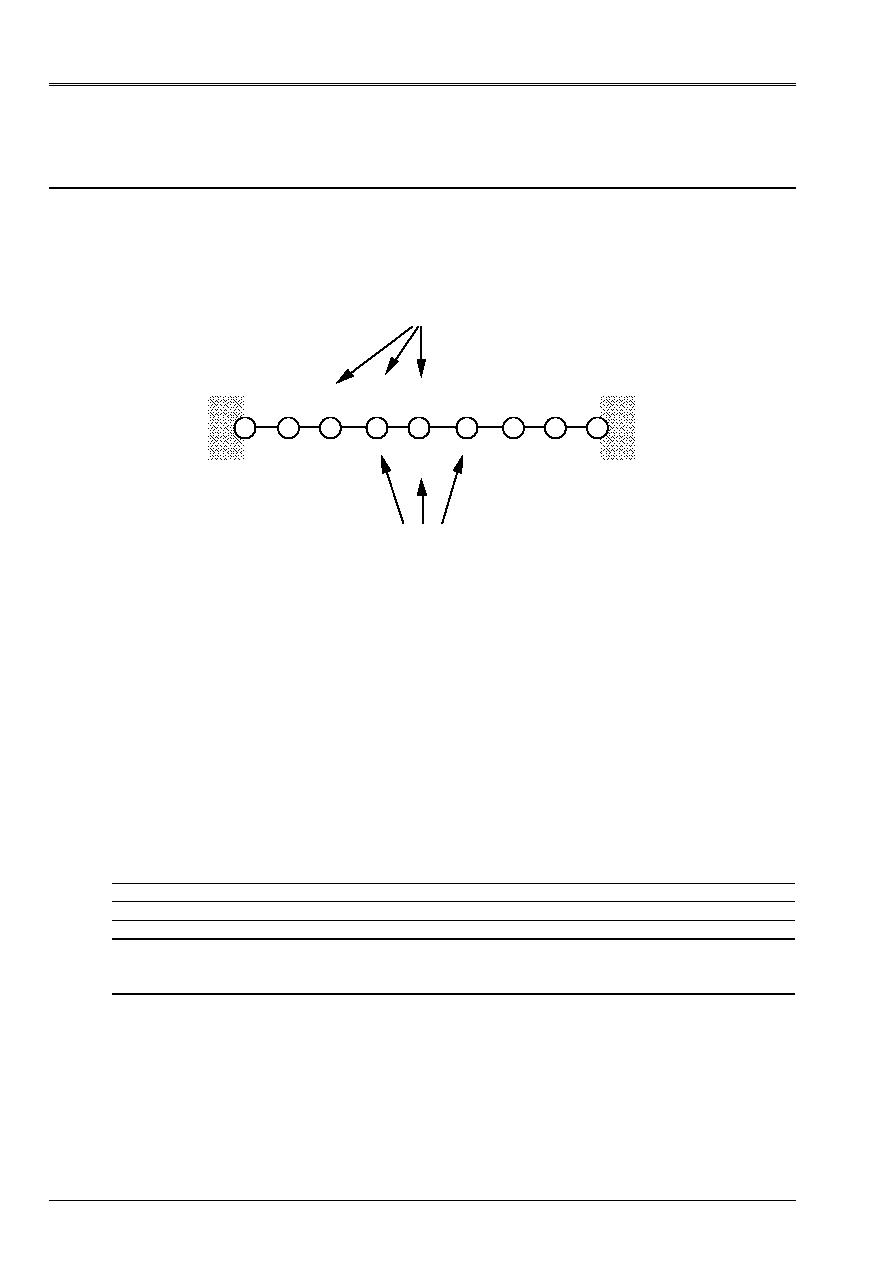
Code_Aster
®
Version
5.0
Titrate:
SDLL106 Beam subjected to a random excitation distributed
Date:
29/08/00
Author (S):
J. PIGAT
Key
:
V2.02.106-B
Page:
1/6
Manual of Validation
V2.02 booklet: Linear dynamics of the beams
HT-62/01/012/A
Organization (S):
EDF/RNE/AMV
Manual of Validation
V2.02 booklet: Linear dynamics of the beams
V2.02.106 document
SDLL106 - Beam subjected to an excitation
random distributed
Summary:
An Bi-embedded beam is subjected over all its length to an effort distributed. Profile of distribution of the force
is identical to all the frequencies.
The random movement of this beam is evaluated by a stochastic approach: the density is determined
spectral of power of displacement in various points of the beam.
The two possibilities are tested:
·
space function of the efforts applied with interspectre unit (method 1),
·
interspectre builds directly for the excited ddl (method 2).
This test is an illustration of the response of a structure subjected to a Eolienne excitation.

Code_Aster
®
Version
5.0
Titrate:
SDLL106 Beam subjected to a random excitation distributed
Date:
29/08/00
Author (S):
J. PIGAT
Key
:
V2.02.106-B
Page:
2/6
Manual of Validation
V2.02 booklet: Linear dynamics of the beams
HT-62/01/012/A
1
Problem of reference
1.1 Geometry
excitation
obstacle
flexible
DX
DY
Beam:
Square section: 0.001 m X 0.001 m
Length: 0.8 m
One does not take account of the field of gravity.
1.2
Material properties
Young modulus:
E = 2.1 E+11 NR
Coefficient of compressibility:
= 0.3
Density:
= 7000 kg/m
3
1.3
Boundary conditions and loadings
The beam is embedded at the two ends.
Ddl DZ is locked in any point.
The effort applied is distributed with the following space distribution:
P1
P2
P3
P4
P5
P6
P7
P8
P9
01
/
2
1
0
L/4
L/2
3l/4
L

Code_Aster
®
Version
5.0
Titrate:
SDLL106 Beam subjected to a random excitation distributed
Date:
29/08/00
Author (S):
J. PIGAT
Key
:
V2.02.106-B
Page:
3/6
Manual of Validation
V2.02 booklet: Linear dynamics of the beams
HT-62/01/012/A
2
Reference solution
2.1
Method of calculation used for the reference solution
Direct calculation defines an assembled vector of space distribution of the effort and applies the density
spectral of effort
()
G
FF
on this distribution (method 1).
Broken up calculation defines the excitation as a matrix interspectrale of dimension 3 (equalizes with
a many excited nodes) and apply, in effort imposed on the nodes, the following matrix interspectrale
(method 2):
()
1
4
1
2
1
4
1
2 1
1
2
1
4
1
2
1
4
.G
FF
The two results must be identical without any approximation.
2.2
Results of reference
Spectral concentration of power of displacement of the P3 node at the frequencies: 4., 6., 8., 10. and 12 Hz.
2.3 References
bibliographical
[1]
C. DUVAL “Dynamic response under random excitation in Code_Aster: principles
theoretical and examples of use " - Note HP-61/92.148

Code_Aster
®
Version
5.0
Titrate:
SDLL106 Beam subjected to a random excitation distributed
Date:
29/08/00
Author (S):
J. PIGAT
Key
:
V2.02.106-B
Page:
4/6
Manual of Validation
V2.02 booklet: Linear dynamics of the beams
HT-62/01/012/A
3 Modeling
With
3.1
Characteristics of modeling
Discrete element in translation of the type
DIS_T
P1
P2
P3
P4
P5
P6
P7
P8
P9
Load application
Observation of the DSP of displacement
Elements of beam:
POU_D_T
The exiting spectral concentration is a white Gaussian noise of level 1.
The first 2 clean modes were taken into account in calculation.
Damping is introduced in the form of modal damping into the operator of answer
random dynamics. For all the calculation cases, it is taken equal to 5%
3.2
Characteristics of the mesh
A number of nodes: 9
A number of meshs and types: 8 SEG2
3.3 Functionalities
tested
Controls
AFFE_CHAR_MECA FORCE_NODALE
MODE_ITER_INV
CONSTANT DEFI_INTE_SPEC
DYNA_ALEA_MODAL EXCIT
SIZE:
CHAM_NO
“EFFO”
ANSWER
REST_SPEC_PHYS
3.4 Remarks
The spectral concentrations are expressed in their physical unit. For a force it will be in NR
2
/Hz.

Code_Aster
®
Version
5.0
Titrate:
SDLL106 Beam subjected to a random excitation distributed
Date:
29/08/00
Author (S):
J. PIGAT
Key
:
V2.02.106-B
Page:
5/6
Manual of Validation
V2.02 booklet: Linear dynamics of the beams
HT-62/01/012/A
4
Results of modeling A
4.1 Values
tested
Spectral concentration of displacement at point AM10:
Frequency
Method 1
Method 2
% difference
4 Hz
4.0298E02
4.0298E02
0%
6 Hz
9.2971E02
9.2971E02
0%
8 Hz
9.5164E01
9.5164E01
0%
10 Hz
1.7617E01
1.7617E01
0%
12 Hz
2.6695E02
2.6695E02
0%
4.2 Parameters
of execution
Version: STA 5.02
Machine: SGI-Origin 2000
System:
IRIX 64
Overall dimension memory:
8 megawords
Time CPU To use:
2.39 seconds

Code_Aster
®
Version
5.0
Titrate:
SDLL106 Beam subjected to a random excitation distributed
Date:
29/08/00
Author (S):
J. PIGAT
Key
:
V2.02.106-B
Page:
6/6
Manual of Validation
V2.02 booklet: Linear dynamics of the beams
HT-62/01/012/A
5
Summary of the results
Method 1 (space distribution of the efforts) and indirect method (by decomposition on the three
excited nodes) provide the same result.
This checking ensures a good coherence of the two methods and the quality of their
programming.





